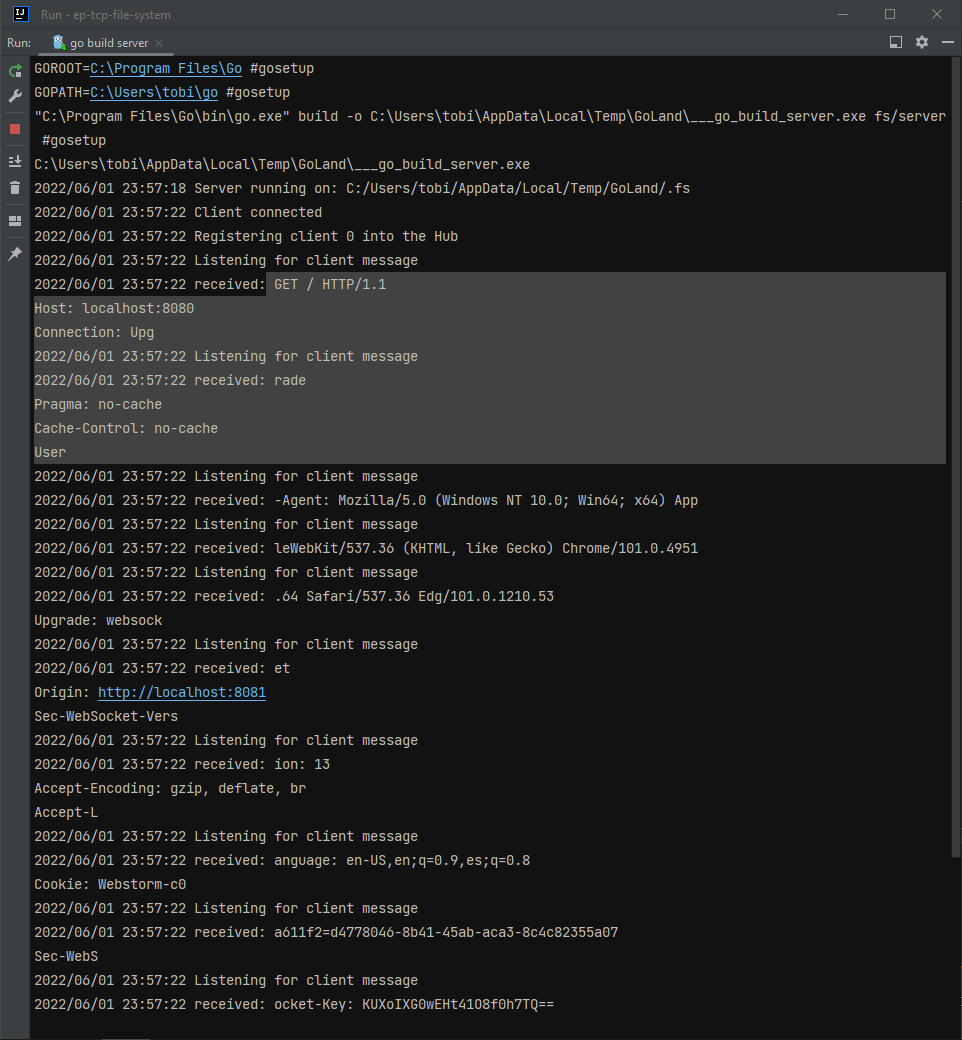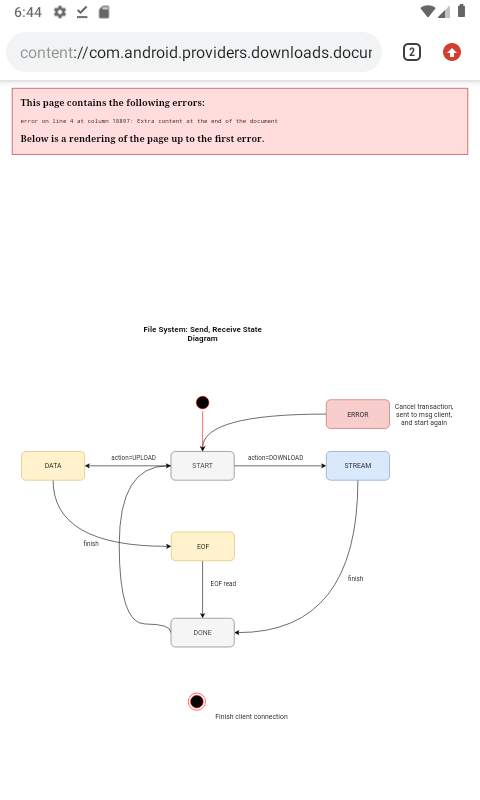ep-tcp-file-system
Example Project for a Go File System server that broadcasts to Android clients.
Plain TCP vs WebSockets
Here comes an issue I recently got: TCP are lower-level connections that send streams as is and have a blocking API whilst Web Sockets are implementations over TCP with asynchronous API.
I care about validating the FSM state in the server and in the client, so I viewed the blocking TCP reads and writes as a good option with the traditional TCP (Java, Go) sockets.
In reality, at the beginning of this project I said that I was going to use Gorilla Web Sockets (a popular Go library) since I used that one the last time for the dungeon game. When in doubt, I ended up using plain TCP, but I still had the question on mind.
Now I can see more details about the project requirements, I need to do two
things: accept a centralized hub of connected users, and fulfilling the
process I defined though the FSM for actions like UPLOAD, and DOWNLOAD.
Engineering principles tell me I have to do one thing right, and I ended up with two responsibilities in the end.
This problem could’ve been addressed in a dummy implementation: read the file (the monolith) and send it to the connection directly. Since a have a lot of experience, that sound really dumb for me personally, I don’t earn anything if I make such implementation, so this example project would not make sense.
I know that files are streamed over the internet, back in the 2000s your download failed at 99% of progress because they were cavemen. Files are just bytes like anything in computers, and I’m an engineer, so if I can imagine it then I can do it, why not?
I also recalled that we can model literally everything as numbers: you can imagine it, then write the code, and inside a computer everything are just bytes or numbers. Everything boils down to numbers or math!
Now going back from the philosophical matrix to the “real world”, I have to separate those two responsibilities, and take a TCP approach: plain TCP or Web Sockets.
Web Sockets
When building the admin app in Vue.js I learned something I was talking about: the client can’t implement TCP sockets as that is a vulnerability issue (they’re too low-level for the browser) so they barely have web sockets (incompatible with my impl).
And web sockets send horrible HTTP headers I had to debug:

Thus, my server didn’t understand the messages.
A solution for this is either to change my implementation to Gorilla Web Sockets or to add some proxy to the connection or some Node.js backend as a proxy between the web client and the Go TCP server.
Using web clients is fundamental as they’re the default clients because everything that runs in a browser is accessible to virtually anyone. So why use plain TCP sockets?
Communication is Key
I defined an FSM on steroids or a state system to define the contracts for the remote computers. I can’t imagine sending files over the network and getting the wrong data!, well, I can, and here we have it in the next capture:
More Side Effects

In the above case, I had overflow when downloading because formal communication between the server and client was not established because of lack of development time!. That’s why upload worked but download had that *little* issue.
As you can see in the image, I was able to open SVG, and PDF files, but not PNG files. Some file formats allow to read overflowed files. That’s why I checked for underflow and overflow in the FSM process since the beginning.
The more you test these pain points, the less nonsense issues you will have later. Or in Uncle Bob words “the only way to go fast is to go well”, let your teams memorize those words, I really mean it.
This is not the first time I apply this obviously, but I have the chance to illustrate it here, so now you now.
TCP and WebSockets are Different
These protocols are both TCP but have different APIs as said above.
TCP is not about sending packets but streaming data. Programmers use to use
the annoying old-school line feed \n to “separate” messages. I hate it, so
I employed JSON objects to communicate between computers and just wait for
the file chunks as is when transferring files to avoid the unnecessary
overhead of JSON messages in those network-heavy cases.
So, machines need to have a way to communicate, a.k.a. the custom protocol.
JSON is a great current standard to serialize messages.
After thinking about the general problem, as a mathematician I could only think on a superb FSM: I have a finite amount of states in the server and client, I can move from one state to another, and the objectives can be saved as states.
The nature of a state machine is blocking or linear, unless they’re some kind of non-deterministic automaton (NDFA) that is in multiple states at once, but that’s not the case here.
Now the problem ends up whether to use another port for file transferring, and the main port for connecting the hub of clients or implementing web sockets with an asynchronous message handling.